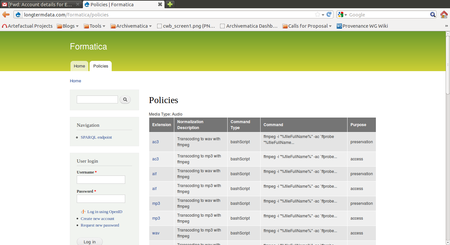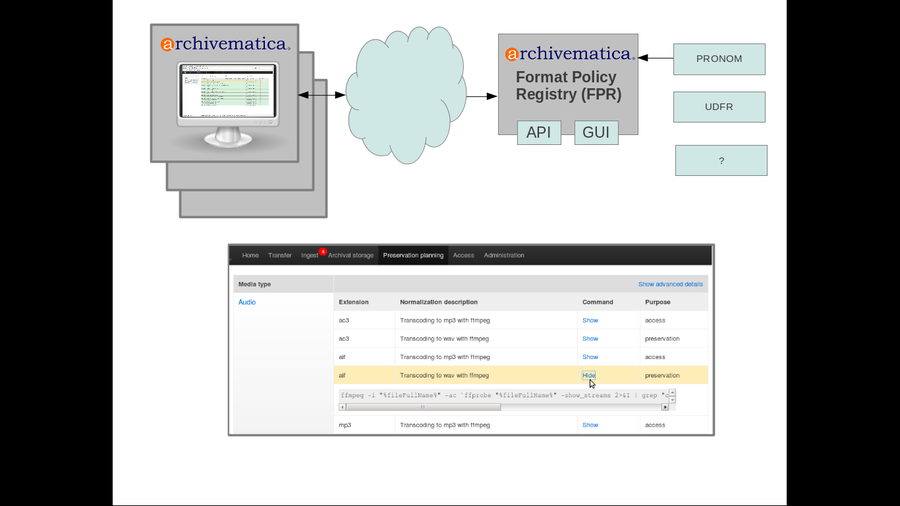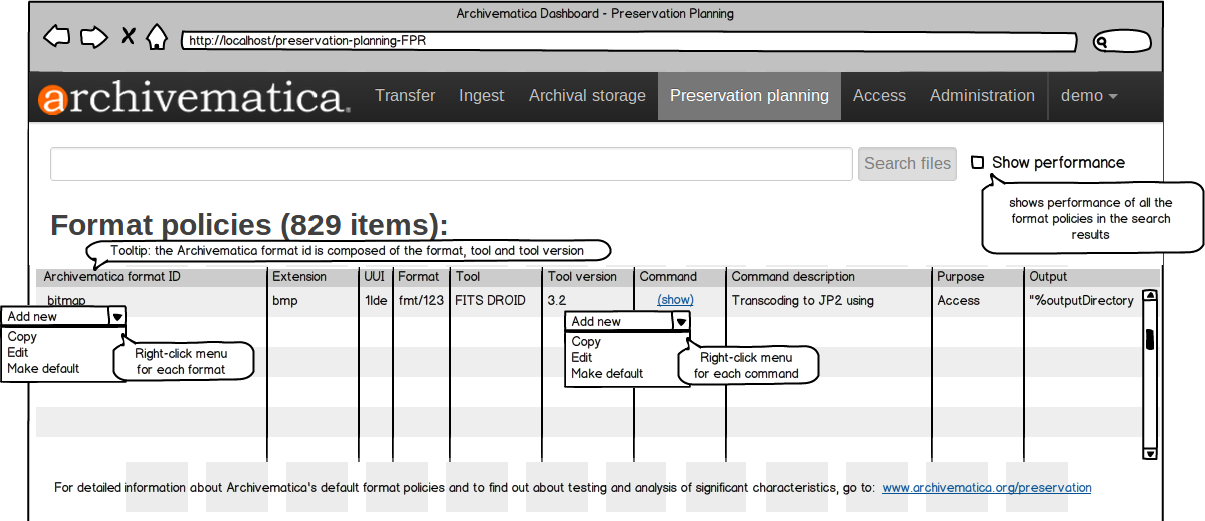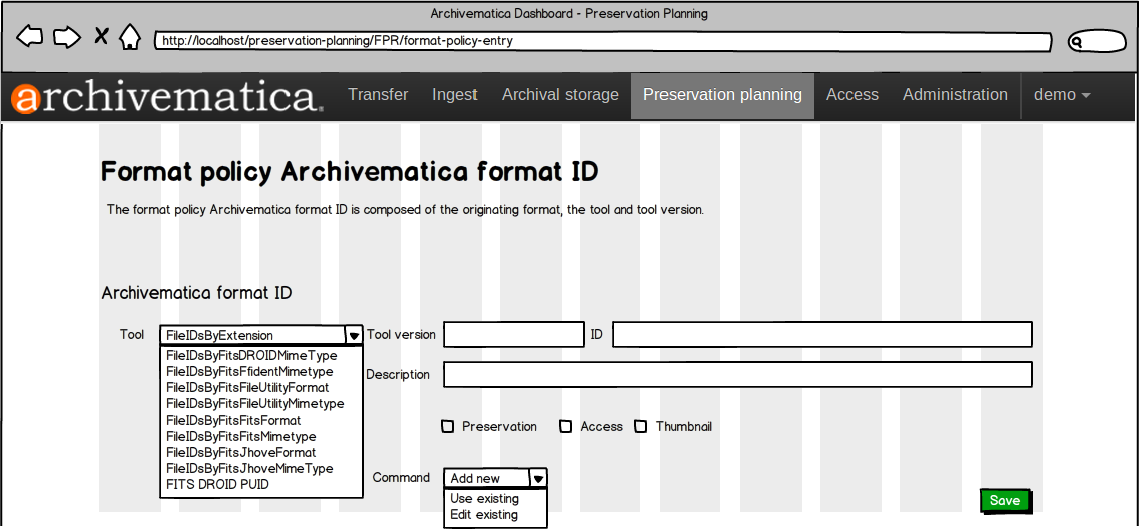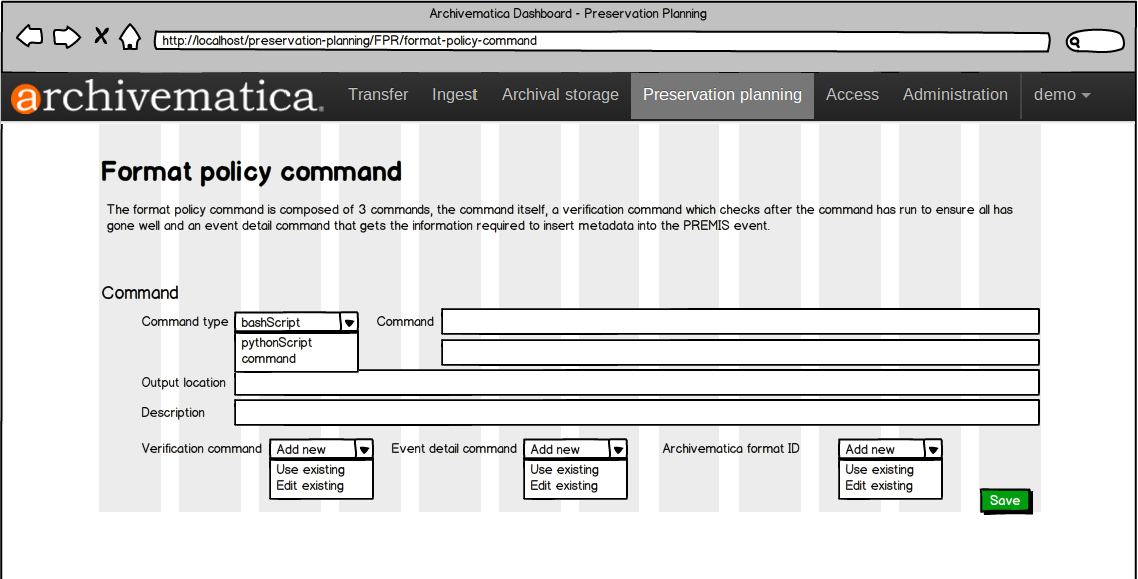Difference between revisions of "Format policy registry requirements"
Jump to navigation
Jump to search
| Line 65: | Line 65: | ||
* Edit -links to edit page for the Archivematica format ID -or- to the edit page for the Command | * Edit -links to edit page for the Archivematica format ID -or- to the edit page for the Command | ||
* Make default - makes the selected Archivematica format ID format policy or the selected Command format policy default for normalization | * Make default - makes the selected Archivematica format ID format policy or the selected Command format policy default for normalization | ||
| + | |||
| + | '''Add new Archivematica format ID''' | ||
| + | |||
| + | [[File:1.0_FormatPolicyFormatID.png]] | ||
| + | |||
| + | '''Add new Command''' | ||
| + | |||
| + | [[File:1.0_FormatPolicyCommand.png]] | ||
== Data Model == | == Data Model == | ||
Revision as of 19:39, 3 January 2013
Documentation > Requirements > Format policy registry requirements
Description
- The Archivematica project team has recognized the need for a better way to manage preservation plans, i.e. business rules and tool commands for format transcoding. Since these are either implemented or altered by the institution running an Archivematica instance, these rules are referred to as policies. Format policies will change as community standards, practices and tools evolve. A format policy indicates the actions, tools and settings to apply to a file of a particular file format (e.g. conversion to preservation format, conversion to access format).
- Until now, the Archivematica project has managed this information on the archivematica.org/preservation wiki page.
- The Format Policy Registry (FPR) will manage this information in a structured format (SQL/JSON).
- APIs with other serializations may be added (e.g. XML, RDF)
- It will be hosted at archivematica.org/fpr/
- The FPR will also provide valuable online statistics about default format policy adoption as well as customizations amongst Archivematica users and will interface with other online registries (such as PRONOM and UDFR) to monitor and evaluate community-wide best practices.
- The FPR stores structured information about normalization format policies for preservation and access. These policies identify preferred preservation and access formats by media type. The choice of access formats is based on the ubiquity of viewers for the file format. Archivematica's preservation formats are all open standards; additionally, the choice of preservation format is based on community best practices, availability of open-source normalization tools, and an analysis of the significant characteristics for each media type.
- These default format policies can all be changed or enhanced by individual Archivematica implementers.
- Subscription to the FPR will allow the Archivematica project to notify users when new or updated preservation and access plans become available, allowing them to make better decisions about normalization and migration strategies for specific format types within their collections. It will also allow them to trigger migration processes as new tools and knowledge becomes available.
- One of the other primary goals of the FPR is to aggregate empirical information about institutional format policies to better identify community best practices. The FPR will provide a practical, community-based approach to OAIS preservation and access planning, allowing the Archivematica community of users to monitor and evaluate formats policies as they are adopted, adapted and supplemented by real-world practioners. The FPR APIs will be designed to share this information with the Archivematica user base as well with other interested communities and projects.
Early prototype
- An early FPR prototype (called "Formatica") was developed by Heather Bowden, then Carolina Digital Curation Doctoral Fellow at the School of Information and Library Science in the University of North Carolina at Chapel Hill.
Requirements
- provide an authenticated Web based interface for creation and maintenance of policies
- provide a read-only RESTful Web API for accessing policies in JSON format
- provide an API for monitoring new and updated policies
- integrate with PRONOM to retrieve PUIDs
- model format policies so that they can be stored in a SQL (MySQL?, PostGres?, SQLlite?) dbase on both client & server
- develop iteratively with an emphasis on getting working code in front of users as quickly as possible to make them part of the design process (see #fileidhack)
- developer notes
Use Cases
- Alternate normalization tool than Archivematica default (preservation and/or access)
- Alternate default normalization outcome format than Archivematica default (preservation and/or access)
- Alternate size normalization result (preservation and/or access)
- Deselect normalization default in Archivematica to use local tool/process outside of the system (preservation and/or access)
- Add new format policy for an unrepresented or new format (preservation and/or access)
- Test format policy tools and commands on local digital acquisitions
Mockups
Preservation Planning tab in Dashboard - FPR
- Archivematica format ID is the "description" from the File ID table in the Archivematica database
- Command description is the "description" from the Command table in the Archivematica database
- Purpose is the same as "classification" in the Archivematica database, but is clearer to the user
- Add new -links to create new (blank) form for Archivematica format ID -or- to the create new (blank) form for the Command
- Copy - links to create new form based on this one (populated with current data) for either the Archivematica format ID -or- Command
- Edit -links to edit page for the Archivematica format ID -or- to the edit page for the Command
- Make default - makes the selected Archivematica format ID format policy or the selected Command format policy default for normalization
Add new Archivematica format ID
Add new Command
